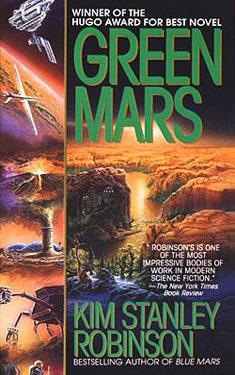Kim Stanley Robinson
Completed 12/11/2013, Reviewed 12/13/2013
3 stars
I think it was a mistake to read “Green Mars” right after
Red Mars. Reading two massive tomes
about the Martian landscape one after the other became a little tedious. The books are structured the same. The saga of living on Mars is told from a
different character’s perspective per chapter.
Where the first book was more about the colonization of Mars, this
book’s plot is the terraforming the planet and the formation of an independent
Martian government. Some action and
characterization takes place, but once again, the primary focus is tons and
tons and tons of descriptions of the environment. Instead of actors chewing the scenery, the
scenery does the chewing.
The book began well, picking up the story of the remaining
first 100 colonists after the war of 2061 and hiding out in the southern
hemisphere, and being told from the perspective of one of the first children
born on Mars. I was excited. The characterization of Nirgal was great, and
the tone was markedly different from the first book. But by the second chapter, the perspective
changed to one of the adults and narrative returned to the same pattern as the
first book.
Several large chapters of the book are simply
travelogues. The premise of one is to
drive around the planet and visit the refuges of the Martians hiding from
Earth’s transnational corporations’ security forces. Another is to drive around and sabotage
transnat installations. The third is to drive
around to all the refuges again and keep them from openly revolting against the
transnats until a coordinated effort can be made. The key phrase here is “drive around”, giving
the author way too many opportunities for descriptive prose. I have to say the prose is good. But it just got tedious.
One character I really liked this time around was Sax. We get a whole chapter of him geeking-out on
biogenetics and the planting and development of his genetically engineered
plants. It may sound tedious as well,
but there was something about his intensity that really engrossed me.
I had a love-hate relationship with Hiroko. She was the lead biologist in the first book
who disappears into the southern hemisphere to become the leader of a Martian
nature cult. She becomes the Mother of
Mars, promulgating a unifying energy among the splintered refugee groups. She is the only person who can, at least
temporarily, bring together terraformists and anti-terraformists, the radicals
and the less-radicals, the old and the young.
At one point, she walks through a huge crowd painted head to toe in
green while her followers get the crowd to chant the names of Mars in all
languages. It’s a weird and powerful
scene. I loved the fact that she is a crazy
embodiment of the Mars experience, but I hated that the character is one
dimensional. There are no interpersonal
interactions with her that tell you who she is.
Did she really go off the deep end and become a goddess, or is there
still a human being in there somewhere?
We don’t get to find out. She’s
simply a colorful enigma.
Nirgal, her son, is also an enigma. We get a good picture of him growing up in
the first chapter. We also find out he
has a strange gift of temperature regulation.
He gets to use it once. He stays
relatively prominent through the first half of the book, but then becomes
one-dimensional as the story continues.
And there is only one more reference to his gift. I was hoping Nirgal and his gift get a little
more focus, maybe adding some magical realism to the story. Maybe we’ll get more in “Blue Mars”.
The conference of refugee groups trying to build a
self-ruling, free Martian world community really worked for me. It was an interesting way to incorporate a
political/philosophical debate into a novel.
And it drew a very realistic picture of how difficult it is to get
people to come to agreement about what freedom means. Not everyone has the same concept of how to
create and Eden ,
and people seem more willing to fight about a few differences than agree about
the similarities.
I gave this book 3 stars.
I wonder if I would have felt differently if I had read it two years
after Red Mars, the time between the publications of each. It’s a really good book, but I just didn’t
feel it as much as I did for the first book.

There's always that danger with reading finished series for the first time. If you like the first one the temptation is to plough straight on the the next, even though a bit of space might have been beneficial for both you and the book. It's like watching a box set, I reckon. The natural week by week tempos and tensions of the drama as originally aired react very differently to being ploughed through in a few days on DVD.
ReplyDeleteStill, at some point I really must get round to these Mars books, pacing regardless.
I agree with you about waiting between books in a series. I did read two other books before starting Blue Mars, and I think that helped a bit. But still, I think these books need at least a few months between installments. Thanks for your comment!
Delete